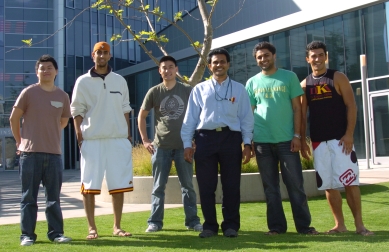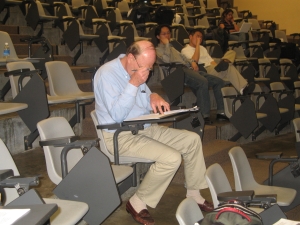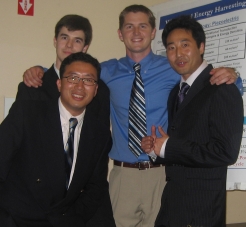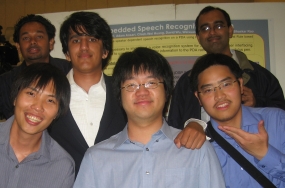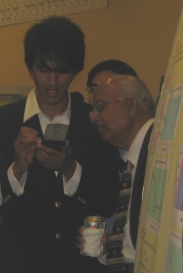Calit2 Continues Support of Student Engineering Design Projects at UCSD
San Diego, CA, June 29, 2006 -- Calit2 continued its ongoing support of the Electrical and Computer Engineering (ECE) department's engineering design course for undergraduates at UCSD by sponsoring or co-sponsoring four of the 12 ECE 191 student teams during spring quarter.
|
"ECE 191 gives undergraduates hands-on experience working with a team on an open-ended project," says Bill Hodgkiss, associate director of the UCSD division of Calit2. "It's an experience valuable to their futures, whether it is in academia or industry." Sponsors and mentors also benefit. "The opportunity to explore and assess new, often untried, technologies benefits Calit2 research projects as well," continues Hodgkiss. "The students' exploration of design trade-offs and the limitations of different technologies often reveals which are worth further investigation." Hodgkiss is also a professor at the Scripps Institution of Oceanography and adjunct professor in ECE.
The final student presentations were held on June 16. The timing was fortuitous: Because graduation was two days away, many parents were in town and attended the presentations, which made for an even larger audience than the usual student teams and their mentors. In addition to ECE 191, Calit2 sponsored another dozen students (three teams) for ECE 192, a new and different version of the design course that originated with a Calit2 researcher (to be discussed in a separate article). They presented with the ECE 191 students.
|
Hodgkiss mentored two teams co-sponsored by Calit2 and Scripps this quarter. Both groups were noteworthy. The first team included Matt Anderson, Ardeshir Aryabod, Chun Chao Chen, and Richard Zhang, they worked on the ongoing "Wireless Sensor Network" project. Past sensor network hardware groups have used evaluation kits in which the wireless device has a sensor board attached to it. One goal this quarter was for the students to attach their own sensor. The team created an end-to-end system with not just one, but two, offboard sensors (a force sensor and a motion [PIR] sensor).
"The end-to-end part is unique; they worked through and executed the whole thing," noted Hodgkiss. The system was designed as a multi-node home or office security system. The idea is that this wireless sensor network can be placed in front of two offices to detect force and motion, that is, determine if someone is about to or has just entered a room. This information is networked to the home security wireless sensor network, then bridged to a more conventional 802.11 wireless system. A PC is set up along the 802.11 network and configured as a web server. All the data can then be displayed remotely on the other side of the wireless network (and viewed by law enforcement and security offices, for example).
Chun Chao 'Johnny' Chen sums up the experience: "This is a wonderful class. We worked together on this and learned something. It's pretty cool."
|
Lance Eischeid, YoungJong Han, Phillip Kim and James McCanna worked on "Energy Harvesting," the other ongoing project that Hodgkiss mentors. The issue in energy harvesting is not wanting, not being able, or it being too expensive, to change batteries frequently on sensor systems in the field. Therefore, the ability to harvest energy from the surrounding environment is crucial.
Hodgkiss found their results "particularly interesting." Building on work from the previous group who created a solar panel recharging battery system, the team investigated what could be done with vibrational energy. They used piezoelectric devices to convert vibrational energy into a small amount of electrical energy to power a wireless sensor node. The students successfully designed a piezoelectric system that can be scaled and tuned to a specific application's power requirements.
"I was there when we first got good voltage out of the device, and it starting working. It gave me a great feeling," says James McCanna, who found the course to be a "wonderful experience."
Not surprisingly, in comparison testing, the team found that energy harvesting from vibrations results in a considerably lower level of energy than that of solar panels. However, things like bridges and even buildings that wiggle back and forth can generate significant energy, and harvesting of vibrational energy could be considered when solar panels are not viable.
Both the students and the mentors work quite hard on the projects, and a large number find the process very rewarding. "The thing that I think is interesting about this class is that the projects vary so widely from group to group. What you get out of the experience is what you put into it," said wireless network sensor team member, Matt Anderson. Rajesh Hegde, a Calit2 postdoctoral researcher in ECE agrees: "It was an enjoyable experience working with the ECE 191 students, even though it involved quite a bit of work from my side. It was a good learning experience, too."
|
With Calit2 academic participant and ECE professor Bhaskar Rao, Hedge mentored Abdifatah Hagisufi, Wei He, Adam Ansari, David Wu, and Chieh-Wei Huang on "An Embedded Speech Recognition System." This quarter the aim was to develop an embedded speech recognition system, possibly in real time, using a small wearable device, such as a PDA. To improve interaction with devices such as PDAs, it is necessary to implement a voice recognition system. Users then are able to use their voice to transfer information to the device by speaking, rather than using a clumsy stylus pen.
The students designed a speaker-dependent speech recognition system using hidden Markov models and rule-based sentence structuring. They found that while rules are a simple and efficient way to implement speech recognition, they cannot obtain results comparable to language models. Therefore, they concluded that language models should be integrated into the PDA, if possible.
"It was a good learning experience that will help us out in the real world," explained Adam Ansari. "The course was very similar to the internship that I have right now. It gives everyone a chance to learn about the design process, whether they have an internship or not while in college."
|
The goal of the "Designing High Capacity Wireless Mesh Networks" project is to develop new solutions and protocols for high-capacity wireless mesh networks. Sanjay Gidvani, Vasilios Ikosipentarhos, Wo Chio Lao, Vishal Sidhpura, and Michael Tsui were mentored by Calit2 postdoctoral researcher BS Manoj and Ramesh Rao, director of the UCSD Division of Calit2 and an ECE professor. "The students came up with several interesting observations and potential solutions for increasing the capacity of mesh networks with a string topology," notes a pleased Manoj.
ECE 191 is an upper-division class that is part of the design requirement and is typically taken by seniors. The primary goal of the course is for students to experience engineering design from concept through building, development, and testing, as well as to learn about working in a group. Because they work on one aspect of an ongoing project, they are not expected to produce a completed product. ECE professors Pankaj K. Das and Clark Guest are the instructors.
ECE 191 projects are funded and/or mentored by campus organizations such as Calit2 and Scripps, corporate affiliates of the Jacobs School of Engineering, and government organizations such as SPAWAR (who sponsored two groups this spring). Corporate affiliates Raytheon and Ler Technologies, Inc., participated this quarter. In addition, San Diego Fire Rescue Air Operations teamed with Anokiwave Inc. to sponsor a group.
Related Links

